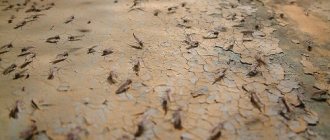Summer residents and gardeners have long been aware that if their plot is replete with fresh mounds of earth, it means moles have settled there. Despite the fact that these are completely harmless animals, they are a real disaster for a summer cottage. These pests can significantly damage garden crops by digging passages and holes underground.
If there are moles on your dacha or garden plot, you can resort to various methods to get rid of them, the main thing is to choose the right remedy. But this is also not a problem if you are aware of how this or that method works.
From this article you will learn how to permanently get rid of moles in the garden. Thanks to our advice, your dacha or garden will be improved and will delight you with a new harvest.
Fighting moles. Folk methods.
One of the first ways to combat the “underground pest” in Russia may be a description in a book published during the reign of Catherine II. It, in particular, said: “Take garlic and onions, also camphor and powder all together, stick them into the wells where they come out, and shut them up tightly, then all underground animals will disappear.” “Take a bunch of green hemp, stick it into the wells and cover it well with earth... When the hemp rots, it creates a great stench, from which every reptile dies or runs away. You can also put a herring head in the discovered hole, which the mole also really doesn’t like, preferring to move to another place (though, when the herring spirit disappears, it will soon return back). A piece of tow moistened with kerosene or tar can repel a mole longer.”
Let's divide all the folk methods of fighting moles into groups:
Protecting the area from animals
There are two really very reliable ways to prevent moles from entering your summer cottage:
- Along the entire perimeter of the site, a metal mesh with a mesh size of 1-2 cm, no more, is buried in the ground to a depth of 50-80 cm (or a durable plastic mesh is used). It is desirable that its top protrudes 10-20 cm above the ground surface. This is an insurmountable barrier for the mole. Theoretically, he can dig a passage under this grid, but almost never does this;
- Or a strip foundation 50-60 cm deep is made in the ground along the entire border of the plot. Fact: in areas completely surrounded by a fence with such a foundation, moles never appear.
It is clear that such work is very labor-intensive and expensive, but in general it is usually carried out not only to combat moles, but also to improve the area (to install a fence, prevent flooding or soil movement). Therefore, if there is an opportunity to do this, then you need to do it: when the neighbors cry about the fact that their entire plot is dug up by moles, you will already forget what the traces of the vital activity of these animals even look like.
Protective or preventive (humane) methods of mole control.
1. Fight against moles. Folk methods. Protective or preventive (humane) methods of mole control. They are aimed at peacefully expelling the enemy from the site, as well as preventing him from entering the territory. They include the use of petroleum and chemical products, as well as other foul-smelling substances, the installation of homemade repellent devices, flooding, fencing the area, and the most humane one - planting natural repellents. And now about each method in more detail:
Use of odorous substances and liquids.
Fighting moles. Folk methods. Along the path of the mole, in each more or less fresh mole hole, make a hole with a drill or a stick up to the horizontal gallery and pour in a glass of a mixture of 2 parts fuel oil and one part kerosene, after which the hole is filled with earth and trampled with feet or into the horizontal passages of the mole, as well as and in molehills, they put pieces of mothballs, rotten fish, bleach, tobacco and shag, rags and tow, soaked in oil or tar. The mole goes away from the bad smell. By this measure, it can be removed, however, only temporarily, because the animal will subsequently return again from the places of exile.
Fighting moles. Folk methods. Installation of repellent devices.
One of the simplest devices for fighting moles and shrews is a spinner made from a plastic bottle. To make it you will need
a piece of ordinary water pipe and a plastic bottle. Pieces of pipes are driven into the ground so that their lower end is deeper than the level of the animal’s passages. A pin with a diameter of 8-10 mm is driven into the upper part of the pipe, strengthening it in the center of the pipe with a wooden plug. Using a hot nail or metal pin, burn a hole in the bottom of the bottle with a diameter larger than the diameter of the pin. Slots are made on the bottle along a solid line, and the plastic is bent along a dotted line. There should be 4 such bends. At the slightest breath of wind, the bottle rotates, the hollow pipe resonates and creates a noise that animals are afraid of. On
Rice. Pinwheel made from a plastic bottle
a plot of 20 - 30 acres, 10 “rattles” will be enough.
Or place several noisy weather vanes with a propeller, putting a tin can of stones on the axis of each of them. Insert a pin (2 m) into the ground. The wind blows, the propeller rotates, the pebbles in the tin jar rattle, and their sound is transmitted along the pin into the ground.
It's a good idea to use bottle trills. To do this, an empty champagne bottle is dug into the ground in an open, ventilated place at an angle of 45 degrees relative to the soil surface. The howling of the wind in empty bottles scares away these animals.
Fighting moles. Folk methods. The old-fashioned method of expelling moles from the garden: break a reed 1.5-2.0 meters long and insert a reed into each hole that goes to the surface of the soil, so that 60-80 centimeters remain on the surface. Moles cannot see, but they hear well. In windy weather, reeds create the effect of “the howling of the wind in a chimney” and in some inexplicable way affect moles. The effect is unexpected. The moles disappear within a week. Old people say that this method is already 200 years old.
Fighting moles with poisonous gases.
Poisonous gases, known in the market as “gas bombs,” are effective in controlling moles. However, it is not recommended to use these gases for an extensive network of tunnels, since the mole usually quickly and tightly closes the gassed section and continues on its way to new territories, expanding the tunnels
Fighting moles. Folk methods. Advice from the Internet. Another humane advice is to “smoke out” the mole. It turns out that the mole cannot stand bad smells. But not rotten fish, as is sometimes written, but the smell of sulfur smoke.
My husband and I tried this method on our parents’ property, and it worked great. After we carried out such fumigation, we discovered that a fresh passage had been laid from the vegetable garden to the neighbor’s land and then through his entire plot to the forest. The passage was made hastily, almost on the surface of the earth and without any turns. The moles left the area forever.
So, we take a sulfur bomb “FAS” (the one that is usually used to disinfect the cellar). We tear up the wormhole a little, put a checker there, set it on fire and cover it with an old plastic bucket. When a bomb is burned, a very unpleasant odor is released, which spreads along the mole tunnels and drives out these cute, but overly proactive rodents for a long time.
Fighting moles. Folk methods. Fighting moles using flooding.
Flooding holes with water from a garden hose is rarely effective. Unless you quickly flood the entire burrow system, which is rarely possible, you may only stimulate the activity of the mole, which will begin to dig tunnels in other parts of the site.
Installing fencing and plowing the area.
To protect any small area (seed beds, areas with cuttings, garden, vegetable garden, flower beds, etc.) from the invasion of moles from a neighboring area inhabited by them, odorous substances similar to the above are suitable, and it is possible to follow along the border of the protected area often make holes with a stick, pour a small amount of tar, tar, kerosene, oil, etc. into them. The moles do not go beyond the line of these holes.
Fighting moles. Folk methods. The protected area can also be surrounded by a ditch 8-10 cm wide and 70 cm deep and filled with shards of broken glass, shards of broken dishes, pieces of prickly rose hips, thistles and other prickly objects mixed with small crushed stone, gravel or earth. Digging in the ground and reaching an obstacle, the mole can injure its delicate trunk, which causes it to die; at best, he turns back without going inside the fenced area. But the mole can make its way under the protective groove, or, coming to the surface of the earth, cross the groove and thus penetrate into the fenced area. Therefore, it seems to me that this measure deserves little attention.
Fighting moles. Folk methods. A fairly reliable means is to surround the entire site with a kind of “fence” of sheets of slate, tin, linoleum and other “molecular-transparent” materials vertically dug into the ground to a depth of 1 - 1.5 meters. You understand that this will “eat up” a lot of time and human resources.
Periodically plowing the area to a sufficient depth (at least 70 cm). Effective, very expensive and not always suitable - after all, something on the site should grow and please the eye.
Natural Pest Control – Planting “Living Repellents”
Many success stories in mole control are based on planting certain plants whose smell moles cannot stand. Of course, this alternative method is less reliable than using traps, pesticides or repellents, but it is also more fun. The advantage is that they are attractive plants that are worth growing on their own. Therefore, if you want to get rid of moles, but do not expect quick results, using plants as a natural remedy is just for you.
Fighting moles. Folk methods. Some bulbous plants are believed to repel moles. One of them is the well-known narcissist . Two others are also classic spring flowering plants, although not as well known as the daffodil: Scilla siberica and Fritillaria imperialis.
Scilla has drooping bell-shaped flowers in lavender, blue, white or pink. Over the years, the woodland spreads and covers the area.
The imperial yellow fritillary , Fritillaria imperialis 'Lutea', has 6 to 8 drooping yellow flowers. The smell of the bulbs is said to be reminiscent of a fox, which is certainly not a pleasant smell for moles. These plants are up to 8 cm in height.
The Allium family consists not only of garlic, onions, leeks, chives and shallots, but also contains ornamental flowering onions. The latter is often simply called Allium. It is an unusual flowering plant with a height of 15 to 150 cm. Garlic is also considered a repellent plant, but from an aesthetic point of view, Allium may be a better choice for you.
Allium giganteum is one of the tall ornamental allium plants, reaching a height of 90-150 cm. The flowers are purple and form round racemes 10-15 cm wide. Since its leaves die back in early summer, you will probably want to cover it with another plant. To make up for this deficiency, simply plant other plants of the onion family. Bulbs can be planted in autumn or spring. To a depth of 15 cm.
Fighting moles. Folk methods. We plant milkweed and castor beans to repel moles.
Marigolds (Tagetes minuta) are a strong-smelling plant widely used for interplanting because of their ability to repel pests. The use of companion plants is an example of organic control methods. Gardeners who prefer organic methods of control should not stop at all with ordinary marigolds. You can name a couple of plants that have an exotic touch, for example, caper spurge and castor bean.
One of them gained its fame as a living repellent, and is often called the “mole plant.” This is caper spurge (Euphorbia lathyris) - an annual plant. But it readily reproduces by self-sowing. The mole plant has an impressive structure and is often grown as an ornamental plant, erect with lanceolate leaves. Its leaves are marked with graceful white veins. When the stem is cut, white sap will flow. Most likely, the smell of this poisonous, pungent juice repels moles.
And finally, castor bean (Ricinus communis). Also known as castor oil plant. As previously mentioned, commercial preparations contain castor oil. In the past, castor oil was used as a laxative and as such its repellent properties can be attested to by a large number of people. And it seems that moles don’t like it as much as people do. Attention: castor bean fruits, like milkweed, are poisonous. None of these plants should be grown where there are small children.
In temperate zones, castor bean is considered an annual plant. It grows quickly and can reach 4.5 m in height, suggesting another use for this plant, namely as a screening (hedge) for those who do not have time to wait years for the shrubs to grow to the desired size. Castor beans have large, star-shaped leaves that make them a very attractive plant.
Fighting moles. Folk methods. The most humane way to combat moles is to plant ordinary Russian beans on the plot. The mole dislikes them so much that he avoids the plantings.
Tube mole traps, purchased and made by yourself
The classic mole trap in the form of a pipe has a fairly simple design: it is a plastic or metal pipe with a diameter of approximately 9-12 cm (the average diameter of a mole's stroke), with doors on both sides on the top hinges. The doors of the mole trap-pipe open easily inward, but do not open outward.
A mole trap made according to this principle is called a Solomon's trap.
In order to catch a mole, a pipe trap must be installed in the excavated passage of the animal. The mole, moving along the tunnel, comes across a door, pushes it forward and crawls inside the trap. The door falls down under its own weight, and the animal can no longer open it from the inside.
If the second mole follows the first one, it will also crawl into the trap and remain in it, and the animals can climb into the live trap from different sides.
On a note
There are cases when, when checking, up to 3 moles were found in one live trap at once. Sometimes shrews are caught in the pipe trap together with the mole. During the day, some gardeners managed to catch 6 moles with such a trap.
You can easily make a pipe mole trap with your own hands from scrap materials. In a piece of pipe you only need to make light hinges for the doors, and also provide a stopper for opening the door outward. The easiest way is to make the door itself higher than the pipe passage (in fact, oval-shaped), and hang it on a hinge inclined inward.
Variants of such traps available for sale cost approximately 200-400 rubles.
In the West, special plastic mole traps are made, from which you can get animals without digging the trap itself. The photo below shows an example of such a device:
It’s also useful to read: How to make a mole trap from plastic bottles with your own hands
Another version of a trap that works on the same principle is a design of several plastic bottles inserted with their necks one into the other. The necks of the bottles are cut with scissors in several places to create easily retractable petals. The mole, crawling into such a “neck,” presses the petals inward with the weight of its body, penetrates into the central section of the trap, and then cannot move the plastic petals apart to crawl back out.
This mole trap made from plastic bottles is exclusively a product of folk art. It’s easy to make with your own hands, having on hand three bottles of the same size, scissors and tape.
Fighting moles. Folk methods. Extermination measures.
Mole poisoning.
Fighting moles. Folk methods. It is known that the mole always keeps his galleries in good order and the damaged ones are always put in order; he begins this, however, only when he feels in danger; This characteristic feature of the mole is used when fighting it.
To poison moles in the soil, they resort to the following means: they dig up and collect ordinary earthworms, put them in a clean wooden bowl, sprinkle them with a poisonous powder such as arsenic, cut them into not particularly small pieces and then immediately lay them out with wide tweezers in small portions into the ground in horizontal galleries and molehills. , and the holes made with a stick are carefully filled with earth or, for control, covered with a piece of turf. Poisoned worms do not lose their signs of life for 15-20 minutes. and the moles, guided by their excellent sense of smell, search for and soon eat the live bait and die.
Of course, the use of strong poisons to kill moles, if done carelessly, is not safe, because there is always the possibility that some of the poisoned worms may be dropped during work and, not falling into the ground, but remaining on its surface, will cause poisoning of livestock and birds and other animals found in the area. Poisons, therefore, are not very convenient, especially in relatively large areas heavily populated by moles, and therefore in such places mechanical methods of exterminating the animal should be preferred.
Fighting moles. Folk methods. Advice from the Internet. Poison a mole using regular rat poison.
In practice, we had to make sure that ordinary poison on poisoned grain is not suitable: moles do not eat grain. But minced meat stuffed with poisonous gel is exactly what you need. I bought a plastic tube with transparent “Efa” gel at a hardware store, mixed the gel in a 1:9 ratio with minced meat, rolled it into balls and laid it out in holes. After about a week, the moles completely disappeared.
Folk traps and other methods of catching moles.
Fighting moles. Folk methods. “Silent hunting” method.
This method was also used by workers in the Gatchina menagerie of the Imperial hunt. If you don’t have mole traps at your disposal, then the simplest way to destroy a small number of moles, for example, in flower beds, nurseries, etc. small spaces, consists in the fact that a worker, armed with an iron shovel, stands at the place where the mole forms its molehills and watches for the animal: at the moment when the latter throws the earth out, this worker quickly thrusts the shovel into the ground across the path near the molehill , throws the mole out and kills it. Now this method has been improved by adding another shovel.
Two shovel method.
You dig up a fresh pile and wait for the mole to crawl in to close the passage (he doesn’t like drafts). With the first shovel you block his escape routes, and with the second you actually do your job.
Fighting moles. Folk methods. “Pan” or “jar” trap
The most effective simple “home” traps are the “pot” or “jar” method. It is as follows: in the middle of the mole’s active move, below its level, a saucepan or a three-liter jar bursts in (with or without water); It is convenient to use a garden auger for this purpose. After this, I cover the hole with a layer of turf, supported by two sticks placed crosswise directly on the ground above the hole. The mole, usually moving very quickly along its underground passage, not suspecting any danger to itself, ends up in a jar, from which it is no longer able to get out.
Solomon's trap.
Then the moles are also caught using a very simple Salomon trap.
Rice. Salomon's mole trap, set to work.
This trap is a cylinder 35-40 cm long and of such a diameter that it fits freely in the horizontal gallery of the mole; a mole can freely pass through the cylinder and also fit into it among several specimens; the ends of the cylinder are open and hanging doors d' are attached to them, opening only inside it; they cannot open outwards, being delayed by the curved lower edge of the cylinder. The Salomon trap is inserted into one of the horizontal passages of the mole, after which it is covered with earth from above and the installation site is marked. A mole, moving along its course, can fall into a trap from both ends, no matter whether it goes in the direction of the arrow, from the right or from the left side of the course, for in both cases it pushes inward the hanging doors d', which, after its entry, themselves close immediately, making it impossible for him to escape the trap. Salomon's mole trap, like the above-mentioned jar, can be used with great benefit during the second half of summer, when the female mole leads her almost grown cubs to hunt for earthworms; in such cases, as already mentioned above, not only whole broods of moles, but also several families can fall into traps in a short time without rearranging the trap.
Fighting moles. Folk methods. The Salomon trap is so simple in design that it can be made using home remedies, and the material for its construction can be wood, tin or light galvanized iron.
Fighting moles. Folk methods. Hooks.
Advice from the Internet. We catch moles with hooks. The principle is this: I dug up a hole and put two fishing hooks in both directions into the tunnel (it’s better to take three-pointed hooks). I tied the hooks with wire to the fittings so that they wouldn’t be dragged away. The mole crawls and clings to the hook and cannot escape anywhere.
Curious methods of struggle (or what they write on the Internet)
Among the oddities, the following methods of struggle can be cited:
1. Shooting from a gun at the newly appeared “holes” (it’s better to immediately throw a bomb on the site! You don’t have to wait for the slides to appear and a random shootout with frightened neighbors won’t start either...) and hitting the same fresh molehills with a shovel (“jamming” the moles) . If you are a risky person and have absolutely nothing to do, these methods are for you.
2. You need to throw dog poop (fresh) into the holes, and the moles go off to dig in the neighborhood. You can get rid of them in about a week.
3. “Not for publication.” The essence of the method is very simple - write in wormholes. Pour the “night vase” into it. An acquaintance had been saving up “reserves” all week and bringing a plastic 5-liter bottle to the site. She claims that she has no more moles.
4. Sometimes firecrackers are thrown into wormholes. I must admit, this helps scare away the animals, but only for a short time. In addition, failure to comply with safety precautions can lead to undesirable consequences, including serious injuries. One small BUT - you need to throw firecrackers into all the holes at once and at the same time, maybe then there will be an effect, and even then it’s more for fun!!!
5. Humor on the forum. In the mole's tunnels, bury stones and mustard: a mole will crawl, get into the mustard, get scared and crawl out of there, hit a stone and die.
Catching moles with a shovel
This method of catching moles is as simple in principle as it is complex in implementation: a gardener with a bayonet shovel waits near the mole’s passages when the animal passes through one of the galleries close to the surface of the earth. At this moment, the ground above him rises slightly, and the movement of the animal is clearly visible. The catcher’s task is to stick the bayonet of the shovel behind the mole and quickly throw the soil with the animal itself to the surface of the earth.
It is also useful to read: How to reliably get rid of moles in a summer cottage or garden plot
The main difficulties of this method:
- Usually you have to spend a lot of time before you can notice the movement of the mole along its course. As a rule, moles inspect tunnels once every few hours, but they may not visit individual branches for days at a time. So there is no guarantee that a person on duty in a certain part of the garden will wait for the animal to appear;
- In addition, the mole needs to be dug up very quickly - the animal moves underground quite quickly, and can avoid the fate of being caught if the gardener is slow.
Nevertheless, the experience of a considerable number of gardeners shows that this method is generally quite effective and widespread: many people catch moles with a shovel.
How to rid a garden of moles (expert advice).
If you have time and desire, you can hunt this animal. You can catch a mole alive: as soon as you see a fresh passage, open it several meters long and leave it open on both sides. The mole does not like fresh air and closes the entrance after 15-30 minutes. Now you know where it is. Bring a sharp shovel with a bucket, and from time to time approach the opened passage very carefully. The Mole will try to restore it for night hunting. Now don't yawn. You can clearly see how the mole digs. You need to carefully approach one meter from the entrance and not worry so that your heart does not beat too much, since the mole detects such vibrations, and stand ready with a raised shovel. When the mole is convinced that there is no danger, it will resume its work. Then you need to forcefully thrust the shovel 30-50 cm behind it and quickly open the passage to the shovel with your hand. The animal will rush around and try to return through a ready move, but it will not be able to overcome the steel. You need to take it between the head and body (otherwise it will bite). Place the caught mole in a bucket and take it away from the garden - to a meadow, to the forest.
Recently, they have begun to sell mole traps of a new design - a piece of plastic pipe, at the ends of which there are two valves made of tin. The valves are secured so that the mole can get inside the pipe, but cannot get out. If a caught mole stays in such a mole trap for several hours, it will die of fear and exhaustion.
What are the nuances when catching a mole with such mole traps?
1. There is no point in installing mole traps during a long drought, since it is useless due to the inactivity of earthworms - at this time the mole slowly walks through its burrows, and there is a possibility that it will bypass such a mole trap. During this period, the mole does not dig much.
2. As soon as you notice sudden activity of moles, which happens before the rain, mole traps need to be installed in the most dense soil (usually paths), where it is difficult for moles to dig, which is why many individuals use such passages.
3. It is necessary to carefully open only such part of the mole's passage where a mole trap could be inserted. The lower edge of the pipe should be buried in the ground, and it is advisable to pour even a little earth up to the valve so that the mole does not notice the slippery walls of the polymer tube. But you can’t sprinkle a lot of soil, as excess soil can prevent the valve from closing behind the mole. This needs to be done on both sides of the mole trap - after all, we don’t know where exactly the mole (or moles) are located. When installing the mole trap, your hands must be clean and you should not smoke during this time.
4. If moles dig in the turf, then it is better to find one path to the last discarded pile and install a mole trap in it. In any case, the mole trap needs to be covered with something on top.
Don't waste time is the main conclusion that follows from the second part of the book. Perhaps, like many, you have heard a lot of advice on how to drive away moles. You might believe that some of them are worth trying. However, in fact, many home remedies and repellents are not effective when dealing with moles; moreover, this gives them time to establish and establish themselves in your garden and then moles become a real problem. Moles can quickly colonize new areas and spread through neighboring areas if prompt action is not taken. Since moles create a well-developed network of passages (tunnels) for their needs, it is difficult to fight them, and the more difficult it is, the longer the passages of their home.
Moles can quickly move their activity from one part of the lawn (or garden) to another. It depends on the climate and soil moisture. Moles respond to changes in the food supply, depending on what insects are available in different areas of the garden at different times of the year. If moles are disturbed, they may leave this area of the garden temporarily, but will usually return when you least expect it. Even if the moles are not disturbed, their activity can only last 1-2 weeks in this part of the garden. This “here today, there tomorrow” behavior is possible and is the root of most misconceptions, which is what gives some home advice the appearance of effectiveness. Therefore, do not waste time, do not try to negotiate peacefully with the recently appeared moles - they will dig long passages and it will become very difficult to get rid of them
We can recommend the following tactics for fighting moles without using poisons: Year-round operation of several electronic repellers, more in summer, less in winter, but the “scarecrowers” should still work in winter. “Scarecrows” should be installed in dense soil, through which sound travels better;
The use of mole traps to control and catch those individuals that have settled and become accustomed;
The use of earthen paths with compacted soil around the perimeter of the garden, in the flower garden and in the vegetable garden around the beds. Compacted and dry soil is a boundary, a barrier for moles; they do not like compacted and dry soil. However, under tiled paths, moles dig well - there is no compacted soil there;
On the contrary, dug up, loose or wet soil or a bed is a potential danger - moles simply love to build many tunnels in the loose soil, as if they were frolicking and playing. As a result, the planted plants end up with their roots up or mixed with the ground. To avoid this, install an electronic repeller near the new planting.
We must not allow moles to get comfortable and build an extensive system of passages. Once they have dug a passage, many generations of moles will use and restore it from year to year (probably by smell), even if it is filled up, along this passage new moles will enter the area instead of those caught. Adding spicy herbs and odorous substances to the passage will help discourage moles from using the passage.
Therefore, it is most reasonable to use electronic repellent devices and traps together to control and catch individual individuals.
Material prepared by: horticulture specialist Buinovsky O.I.
Mole trap, or how to catch a mole in a bucket
This trap is also made from scrap materials. The main task here is to make a hole in the middle of the mole’s passage, into which the animal will fall and will no longer be able to get out of it.
Usually, to catch a mole in this way, they use a deep pan, a bucket (plastic or metal), a glass jar or a cut plastic bottle of large diameter.
The mole trap-pit is formed under the passage of the animal in such a way that its upper edge is at the same level with the lower edge of the underground passage. From above, the entire “excavation site” is covered with a sheet of plywood or other opaque material (so that the mole is not scared off by sunlight). As a result, the animal, simply moving along the way, falls into the installed container.
The photographs below show how a regular three-liter jar is installed for this:
Such live traps are as simple as possible to manufacture and do not require financial investment. Often, a couple of such traps allow you to catch not only all the moles in your garden, but also shrews, voles and other living creatures.
On a note
If a mole and a shrew fall into a pit trap at the same time, then, as practice shows, with a high probability the shrew will soon become a source of food for the mole.











